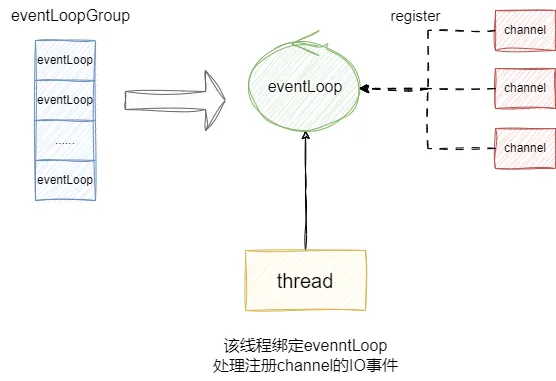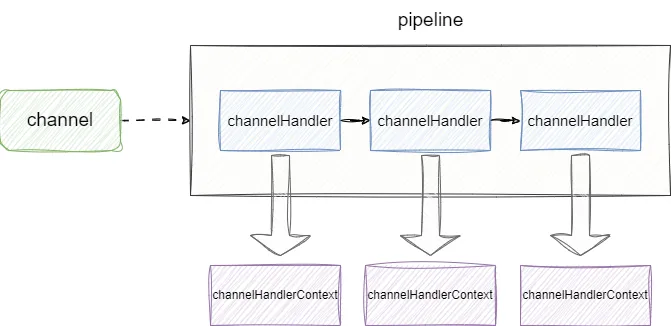由于Netty优秀的设计和封装,开发一个高性能网络程序就变得非常简单,本文从一个简单的服务端落地简单介绍一下Netty中的几个核心组件,希望对你有帮助。

快速落地一个服务端
我们希望通过Netty快速落地一个简单的主从reactor模型,由主reactor对应的线程组接收连接交由acceptor创建连接,与之建立的客户端的读写事件都会交由从reactor对应的线程池处理:

基于此设计,我们通过Netty写下如下代码,可以看到我们做了如下几件事:
声明一个服务端创建引导类ServerBootstrap ,负责配置服务端及其启动工作。声明主从reactor线程组,其中boss可以看作监听端口接收新连接的线程组,而work则是负责处理客户端数据读写的线程组。基于上述线程池作为group的入参完成主从reactor模型创建。通过channel函数指定server channe为NioServerSocketChannel即采用NIO模型,而NioServerSocketChannel我们可以直接理解为serverSocket的抽象表示。通过childHandler方法给引导设置每一个连接数据读写的处理器handler。
最后调用bind启动服务端并通过addListener对连接结果进行异步监听:
复制public static void main(String[] args) {
//1. 声明一个服务端创建引导类
ServerBootstrap serverBootstrap = new ServerBootstrap();
//2. 声明主从reactor线程组
NioEventLoopGroup boss = new NioEventLoopGroup();
NioEventLoopGroup worker = new NioEventLoopGroup(Runtime.getRuntime().availableProcessors());
serverBootstrap.group(boss, worker)//3. 基于上述线程池创建主从reactor模型
.channel(NioServerSocketChannel.class)//server channel采用NIO模型
.childHandler(new ChannelInitializer<NioSocketChannel>() {//添加客户端读写请求处理器到subreactor中
@Override
protected void initChannel(NioSocketChannel ch) throws Exception {
// 对于ChannelInboundHandlerAdapter,收到消息后会按照顺序执行即 A -> B->ServerHandler
ch.pipeline().addLast(new InboundHandlerA())
.addLast(new InboundHandlerB())
.addLast(new ServerHandler());
// 处理写数据的逻辑,顺序是反着的 B -> A
ch.pipeline().addLast(new OutboundHandlerA())
.addLast(new OutboundHandlerB())
.addLast(new OutboundHandlerC());
ch.pipeline().addLast(new ExceptionHandler());
}
});
//绑定8080端口并设置回调监听结果
serverBootstrap.bind("127.0.0.1", 8080)
.addListener(f -> {
if (f.isSuccess()) {
System.out.println("连接成功");
}
});
}1.2.3.4.5.6.7.8.9.10.11.12.13.14.15.16.17.18.19.20.21.22.23.24.25.26.27.28.29.30.31.32.33.34.
对于客户端的发送的数据,我们都会通过ChannelInboundHandlerAdapter添加顺序处理,就如代码所示我们的执行顺序为InboundHandlerA->InboundHandlerB->ServerHandler,对此我们给出InboundHandlerA的代码,InboundHandlerB内容一样就不展示了:
复制public class InboundHandlerA extends ChannelInboundHandlerAdapter {
@Override
public void channelRead(ChannelHandlerContext ctx, Object msg) throws Exception {
System.out.println("InBoundHandlerA : " + ((ByteBuf)msg).toString(StandardCharsets.UTF_8));
//将当前的处理过的msg转交给pipeline的下一个ChannelHandler
super.channelRead(ctx, msg);
}
}1.2.3.4.5.6.7.8.9.
而ServerHandler的则是:
客户端与服务端建立连接,对应客户端channel被激活,触发channelActive方法。ChannelHandlerContext 的 Channel 已注册到其 EventLoop 中,执行channelRegistered。将 ChannelHandler 添加到实际上下文并准备好处理事件后调用。
解析客户端的数据然后回复Hello Netty client :
复制private static class ServerHandler extends ChannelInboundHandlerAdapter {
@Override
public void channelActive(ChannelHandlerContext ctx) {
System.out.println("channel被激活,执行channelActive");
}
@Override
public void channelRegistered(ChannelHandlerContext ctx) {
System.out.println("执行channelRegistered");
}
@Override
public void handlerAdded(ChannelHandlerContext ctx) {
System.out.println("执行handlerAdded");
}
@Override
public void channelRead(ChannelHandlerContext ctx, Object msg) throws Exception {
ByteBuf byteBuf = (ByteBuf) msg;
//打印读取到的数据
System.out.println(new Date() + ": 服务端读到数据 -> " + byteBuf.toString(StandardCharsets.UTF_8));
// 回复客户端数据
System.out.println(new Date() + ": 服务端写出数据");
//组装数据并发送
ByteBuf out = getByteBuf(ctx);
ctx.channel().writeAndFlush(out);
super.channelRead(ctx, msg);
}
private ByteBuf getByteBuf(ChannelHandlerContext ctx) {
ByteBuf buffer = ctx.alloc().buffer();
byte[] bytes = "Hello Netty client ".getBytes(StandardCharsets.UTF_8);
buffer.writeBytes(bytes);
return buffer;
}
//......
}1.2.3.4.5.6.7.8.9.10.11.12.13.14.15.16.17.18.19.20.21.22.23.24.25.26.27.28.29.30.31.32.33.34.35.36.37.38.39.40.41.42.43.
我们通过telnet 对应ip和端口后发现服务端输出如下内容,也很我们上文说明的一致:
复制执行handlerAdded
执行channelRegistered
端口绑定成功,channel被激活,执行channelActive1.2.3.
然后我们发送消息 1,可以看到触发所有inbound的channelRead方法:
复制InBoundHandlerA : 1
InBoundHandlerB: 1
Wed Jul 24 00:05:18 CST 2024: 服务端读到数据 -> 11.2.3.
然后我们回复hello netty client,按照添加的倒叙触发OutBoundHandler:
复制Wed Jul 24 00:05:18 CST 2024: 服务端写出数据
OutBoundHandlerC: Hello Netty client
OutBoundHandlerB: Hello Netty client
OutBoundHandlerA: Hello Netty client 1.2.3.4.
详解Netty中的核心组件
channel接口
channel是Netty对于底层class socket中的bind、connect、read、write等原语的封装,简化了我们网络编程的复杂度,同时Netty也提供的各种现成的channel,我们可以根据个人需要自行使用。 下面便是笔者比较常用的Tcp或者UDP中比较常用的几种channel。
NioServerSocketChannel:基于NIO选择器处理新连接。EpollServerSocketChannel:使用 linux EPOLL Edge 触发模式实现最大性能的实现。NioDatagramChannel:发送和接收 AddressedEnvelope 的 NIO 数据报通道。EpollDatagramChannel:使用 linux EPOLL Edge 触发模式实现最大性能的 DatagramChannel 实现。EventLoop接口
在Netty中,所有channel都会注册到某个eventLoop上, 每一个EventLoopGroup中有一个或者多个EventLoop,而每一个EventLoop都绑定一个线程,负责处理一个或者多个channel的事件:

这里我们也简单的给出NioEventLoop中的run方法,它继承自SingleThreadEventExecutor,我们可以大概看到NioEventLoop的核心逻辑本质就是轮询所有注册到NioEventLoop上的channel(socket的抽象)是否有其就绪的事件,然后
复制 @Override
protected void run() {
for (;;) {
try {
//基于selectStrategy轮询查看是否有就绪事件
switch (selectStrategy.calculateStrategy(selectNowSupplier, hasTasks())) {
case SelectStrategy.CONTINUE:
continue;
case SelectStrategy.SELECT:
select(wakenUp.getAndSet(false));
//......
if (wakenUp.get()) {
selector.wakeup();
}
default:
// fallthrough
}
cancelledKeys = 0;
needsToSelectAgain = false;
final int ioRatio = this.ioRatio;
//根据IO配比执行网络IO事件方法processSelectedKeys以及其他事件方法runAllTasks
if (ioRatio == 100) {
try {
processSelectedKeys();
} finally {
// Ensure we always run tasks.
runAllTasks();
}
} else {
final long ioStartTime = System.nanoTime();
try {
processSelectedKeys();
} finally {
// Ensure we always run tasks.
final long ioTime = System.nanoTime() - ioStartTime;
runAllTasks(ioTime * (100 - ioRatio) / ioRatio);
}
}
} catch (Throwable t) {
handleLoopException(t);
}
//......
}
}1.2.3.4.5.6.7.8.9.10.11.12.13.14.15.16.17.18.19.20.21.22.23.24.25.26.27.28.29.30.31.32.33.34.35.36.37.38.39.40.41.42.43.44.45.46.
pipeline和channelHandler以channelHandlerContext
每一个channel的事件都会交由channelHandler处理,而负责同一个channel的channelHandler都会交由pipeline一条逻辑链进行连接,这两者的的关系都会一一封装成channelHandlerContext,channelHandlerContext主要是负责当前channelHandler和与其同一条channelpipeline上的其他channelHandler之间的交互。
举个例子,当我们收到客户端的写入数据时,这些数据就会交由pipeline上的channelHandler处理,如下图所示,从第一个channelHandler处理完成之后,每个channelHandlerContext就会将消息转交到当前pipeline的下一个channelHandler处理:

假设我们的channelHandler执行完ChannelActive后,如希望继续传播则会调用fireChannelActive:
复制 @Override
public void channelActive(ChannelHandlerContext ctx) {
System.out.println("端口绑定成功,channel被激活,执行channelActive");
ctx.fireChannelActive()
}1.2.3.4.5.
查看其内部逻辑即可知晓,它就是通过AbstractChannelHandlerContext得到pipeline的下一个ChannelHandler并执行其channelActive方法:
复制 @Override
public ChannelHandlerContext fireChannelActive() {
final AbstractChannelHandlerContext next = findContextInbound();
invokeChannelActive(next);
return this;
}1.2.3.4.5.6.
回调的思想
我们可以说回调其实是一种设计思想,Netty对于连接或者读写操作都是异步非阻塞的,所以我们希望在连接被建立进行一些响应的处理,那么Netty就会在连接建立的时候方法暴露一个回调方法供用户实现个性逻辑。
例如我们的channel连接被建立时,其底层就会调用invokeChannelActive获取我们绑定的ChannelInboundHandler并执行其channelActive方法:
复制private void invokeChannelActive() {
if (invokeHandler()) {
try {
((ChannelInboundHandler) handler()).channelActive(this);
} catch (Throwable t) {
notifyHandlerException(t);
}
} else {
fireChannelActive();
}
}1.2.3.4.5.6.7.8.9.10.11.
于是就会调用到我们服务端ServerHandler 的channelActive方法:
复制private static class ServerHandler extends ChannelInboundHandlerAdapter {
//......
@Override
public void channelActive(ChannelHandlerContext ctx) {
System.out.println("端口绑定成功,channel被激活,执行channelActive");
}
//......
}1.2.3.4.5.6.7.8.9.10.
Future异步监听
为保证网络服务器执行的效率,Netty大部分网络IO操作都采用异步的,以笔者建立连接设置的监听器为例,当前连接成功后,就会返回给监听器一个java.util.concurrent.Future,我们就可以通过这个f获取连接的结果是否成功:
复制//绑定8080端口并设置回调监听结果
serverBootstrap.bind("127.0.0.1", 8080)
.addListener(f -> {
if (f.isSuccess()) {
System.out.println("连接成功");
}
});1.2.3.4.5.6.7.
我们步入DefaultPromise的addListener即可发现其内部就是添加监听后判断这个连接的异步任务Future是否完成,如果完成调用notifyListeners回调我们的监听器的逻辑:
复制@Override
public Promise<V> addListener(GenericFutureListener<? extends Future<? super V>> listener) {
//......
//添加监听
synchronized (this) {
addListener0(listener);
}
//连接任务完成,通知监听器
if (isDone()) {
notifyListeners();
}
return this;
}1.2.3.4.5.6.7.8.9.10.11.12.13.14.



